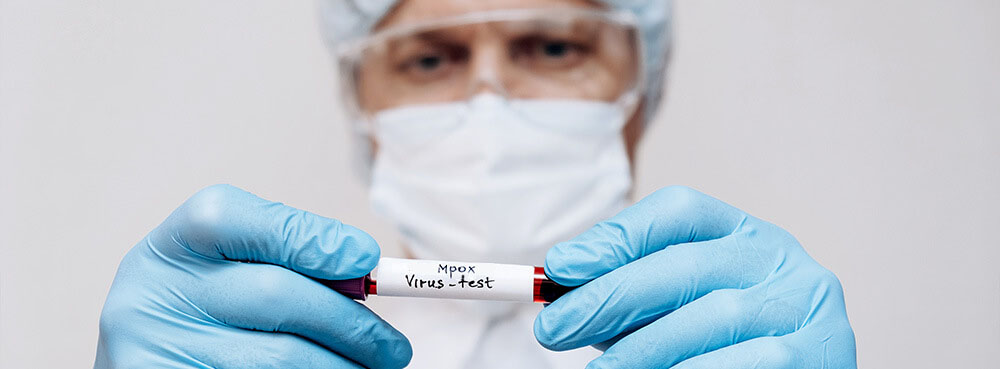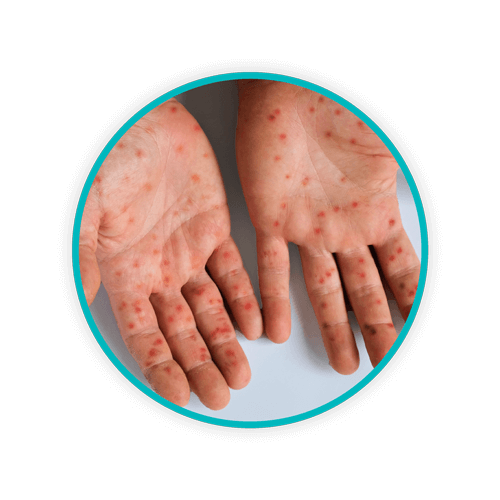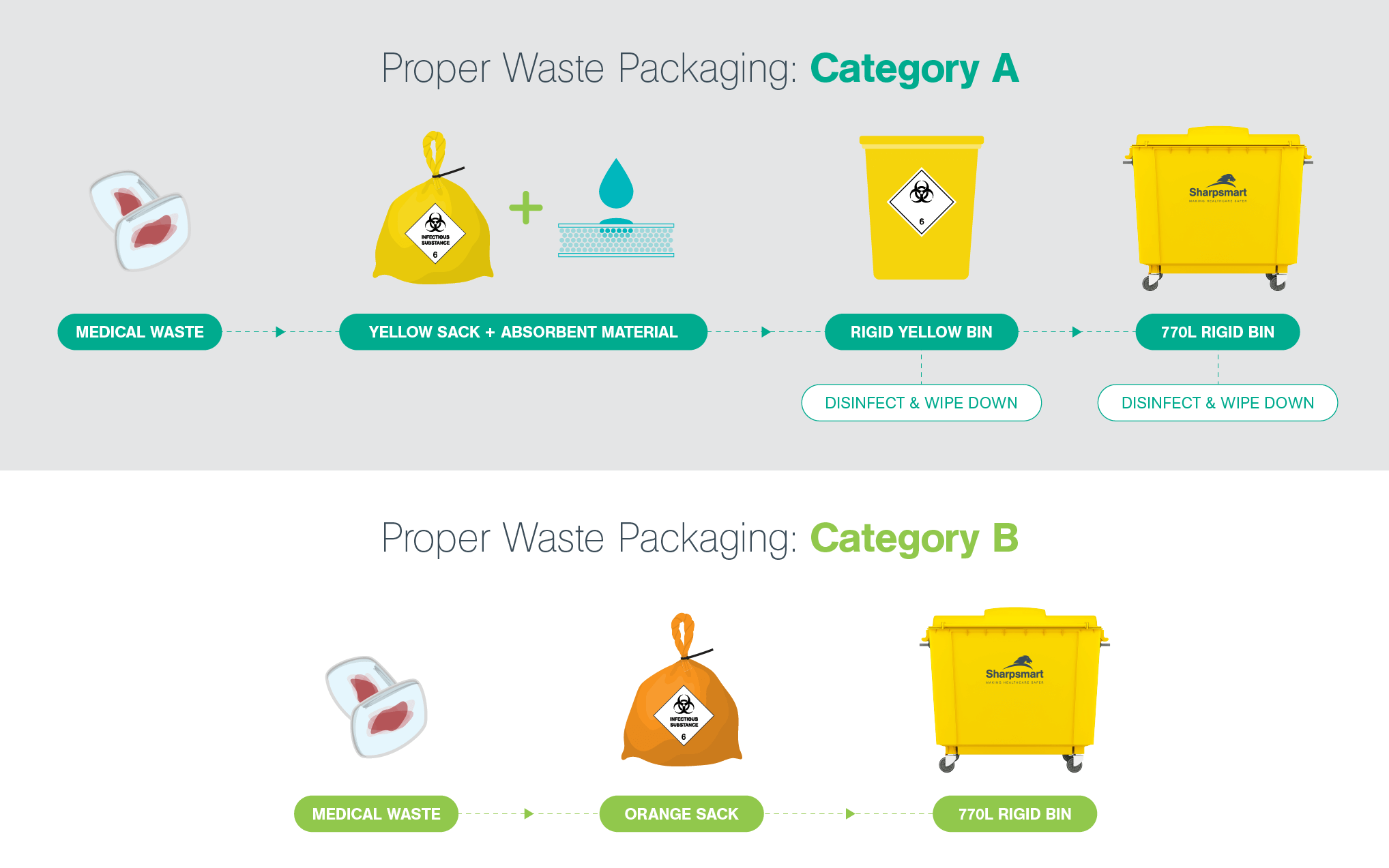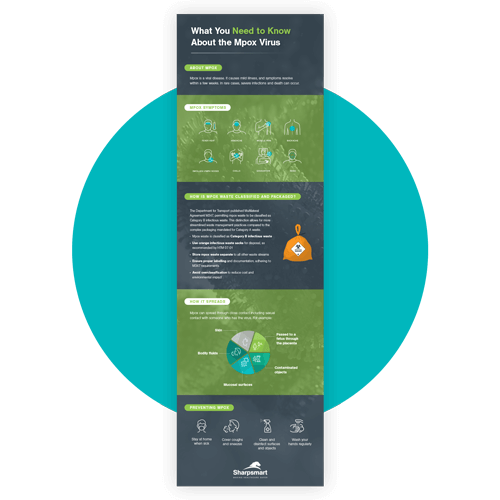Managing Mpox Waste in the Healthcare Setting: A Balanced Approach

Previously known as monkeypox, the global mpox outbreak has prompted widespread concern, underscoring the importance of safe and effective waste management in healthcare settings where suspected or confirmed cases are encountered.
While the UK has experienced a comparatively lower number of recent cases, with 286 confirmed and highly probable cases in 2023 and 2024, maintaining vigilance and adhering to proper waste management protocols remains crucial.
This article offers practical guidance to healthcare professionals, drawing from relevant regulations and expert knowledge.
TOPICS WE WILL COVER:
2 / Mpox vs. Other High-Consequence Infectious Diseases: Waste Classification Matters
3 / Proper Packaging: Simple yet Effective
4 / Specific M347 Requirements for Mpox Waste Paperwork
5 / Avoiding Overclassification: Cost and Environmental Impact
6 / Expert Insights: A Balanced Approach
8 / Looking for Clinical Waste Guidance?
Understanding the Risk
According to the World Health Organisation, over 120 countries have reported mpox between January 2022 and August 2024, with over 100,000 laboratory-confirmed cases reported and over 220 deaths among confirmed cases. Although the majority are concentrated in specific regions, the UK has seen its share, with 4,018 cases since the beginning of 2022.
The mpox virus causing the current outbreak appears to be more transmissible than previous types. Although most cases remain mild, this heightened transmissibility underscores the importance of continued vigilance and preventive measures.
Mpox vs. Other High-Consequence Infectious Diseases: Waste Classification Matters
Despite having a lower mortality rate than other high-consequence infectious diseases (HCIDs) like Ebola, mpox necessitates careful waste handling to prevent further transmission. Mpox waste differs from that of other HCIDs, which fall under Category A and necessitate rigorous three-part packaging.
The Department for Transport published Multilateral Agreement M347, permitting mpox waste to be classified as Category B infectious waste. This distinction allows for more streamlined waste management practices compared to the complex packaging mandated for Category A waste.
M347 is valid until 31 December 2025, unless revoked earlier by one of the signatories. The continued need for this agreement will likely be reviewed as the expiry date approaches, considering factors such as the prevalence of the mpox virus, the effectiveness of existing waste management protocols, and any new scientific or regulatory developments. It’s important to note that cultures of mpox remain classified as Category A waste.
Proper Packaging: Simple yet Effective

When disposing of mpox waste, follow HTM 07-01 guidelines and use orange infectious waste sacks. Secure the sacks using the swan-neck method and keep them separate from other infectious waste. For storage and transportation, use a dedicated, yellow healthcare waste cart. Clearly label the cart for easy identification and ensure it is locked and kept in a secure area.
Yellow clinical waste sacks and single-use rigid containers play a vital role in the safe management of Category A infectious waste. All sacks, containers and carts used for Category A or B waste require UN (United Nations) certification to ensure they meet strict international standards for the containment and transport of hazardous materials, protecting both human health and the environment.
UN certification guarantees that these products have undergone rigorous testing to demonstrate their strength, leak-proofness, and ability to withstand the rigours of transportation – minimising the risk of exposure to infectious substances. This packaging, combined with proper labelling and documentation, ensures safe handling throughout the entire waste management process.
What About Mpox Contaminated Sharps Waste?
Mpox sharps require special handling and disposal in compliance with Multilateral Agreement M347. These sharps should be stored in designated, clearly labelled containers, separate from other sharps waste. You may use reusable or single-use sharps containers. It's also crucial to maintain separate records for mpox sharps on consignment notes.
 Specific M347 Requirements for Mpox Waste Paperwork
Specific M347 Requirements for Mpox Waste Paperwork
Beyond the general requirements for Category B infectious substances, M347 mandates that paperwork for mpox waste also includes the statement ‘Carriage in accordance with Multilateral Agreement M347’.
Avoiding Overclassification: Cost and Environmental Impact
While caution is understandable, overclassifying mpox waste as Category A leads to unnecessary costs and environmental burdens. The two layers of single-use packaging and absorbent material required for Category A create more waste and consume more resources than the single-layer packaging required to safely contain Category B.
Furthermore, the disposal of Category A waste, which requires high-temperature incineration, is typically nearly twice as carbon-intensive as alternative treatments suitable for Category B waste and incurs significantly higher costs.
Expert Insights: A Balanced Approach
In my experience as a waste management consultant, I've observed the challenges healthcare facilities face in balancing safety and efficiency. While adhering to regulations and safeguarding public health is paramount, avoiding unnecessary waste and environmental impact is equally important.
By following HTM 07-01 guidelines and correctly classifying mpox waste, healthcare facilities can ensure its safe and responsible disposal. Moreover, utilising alternative treatment technologies can further minimise the carbon footprint of mpox waste management.
Key Takeaways
- Mpox waste is classified as Category B infectious waste
- Use orange infectious waste sacks for disposal, as recommended by HTM 07-01
- Store mpox waste separate to all other waste streams
- Ensure proper labelling and documentation, adhering to M347 requirements
- Avoid overclassification to reduce cost and environmental impact
This helpful infographic poster shows mpox symptoms, classifications, how it spreads, and how to prevent infection.
By adopting a balanced approach to mpox waste management, healthcare professionals contribute significantly to protecting both public health and the environment.
Looking for Clinical Waste Guidance?
Whether you’re looking for some guidance on classifying and packaging your waste or a reliable clinical waste disposal service that puts you first, we’re here to help.
At Sharpsmart, our mission has always been to make healthcare safer and we’re dedicated to protecting healthcare workers and the environment. Our clinical waste experts work with your teams within the four walls of your organisation, empowering your staff to manage your waste in the most effective way possible.
If you’d like to discover how we can help improve your clinical waste management, please don’t hesitate to get in touch.

